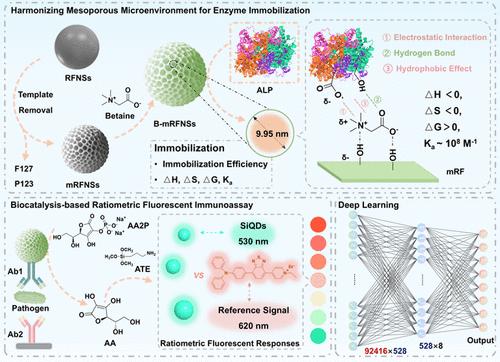Thermodynamic Microenvironment Engineering in Mesoporous Nanoreactors to Enhance Biocatalysis for AI-Empowered Ultrasensitive Pathogen Detection
IF 6.7
1区 化学
Q1 CHEMISTRY, ANALYTICAL
引用次数: 0
Abstract
Harmonizing enzyme-support microenvironments to govern thermodynamic interaction landscapes presents a critical yet underexplored frontier in nanobiocatalysis for pathogen detection. Herein, we architecturally engineer mesoporous resorcinol formaldehyde nanospheres (mRFNSs, 9.95 nm pores) with tailored surface chemistry to elucidate how microenvironment modulation dictates enzyme immobilization energetics. Thermodynamic dissection demonstrates that betaine-tailored mRFNSs with optimal immobilization efficiency and activity dramatically reshape binding energetics, achieving record affinity through optimized electrostatic complementarity, hydrogen-bond networks, and hydrophobic effect. This microenvironment engineering strategy delivers an unprecedented 4.01-fold enhancement in binding constant (Ka = 1.12 × 108 vs 2.79 × 107 M–1) and superior thermodynamic spontaneity (ΔG = −46.0 vs −42.5 kJ mol–1). Leveraging this, we develop a paradigm-shifting ratiometric fluorescence immunoassay where ALP triggers in situ silicon quantum dot (SiQDs) synthesis (530 nm) against tetraphenylbenzidine reference (620 nm), achieving ultrasensitive Salmonella typhimurium (S. typhimurium) detection (100 CFU mL–1), which is 50-fold lower than that of conventional ELISA. A convolutional neural network (CNN) decodes smartphone-captured fluorescence hues, enabling portable classification (93.75% accuracy) of pathogen levels. Validated in food matrices (81.44–116.93% recovery), this work establishes thermodynamic-microenvironment correlations as a blueprint for next-generation nanobiocatalysts, bridging biointerface science with artificial intelligence (AI)-enhanced diagnostics.

介孔纳米反应器的热力学微环境工程增强人工智能超灵敏病原体检测的生物催化
协调酶支持的微环境来控制热力学相互作用景观是纳米生物催化用于病原体检测的一个关键但尚未开发的前沿。在此,我们设计了介孔间苯二酚甲醛纳米球(mRFNSs, 9.95 nm孔),并使用定制的表面化学来阐明微环境调节如何影响酶固定化的能量学。热力学解剖表明,甜菜碱定制的mRFNSs具有最佳的固定化效率和活性,通过优化的静电互补、氢键网络和疏水效应,极大地重塑了结合能,实现了创纪录的亲和力。这种微环境工程策略提供了前所未有的4.01倍的结合常数增强(Ka = 1.12 × 108 vs 2.79 × 107 M-1)和优越的热力学自发性(ΔG = - 46.0 vs - 42.5 kJ mol-1)。利用这一点,我们开发了一种范式转换比例荧光免疫分析法,其中ALP触发原位硅量子点(SiQDs)合成(530 nm)对抗四苯基联苯胺参比(620 nm),实现了超灵敏的鼠伤寒沙门氏菌(S. typhimurium)检测(100 CFU mL-1),比传统ELISA低50倍。卷积神经网络(CNN)解码智能手机捕获的荧光色调,实现便携式病原体水平分类(准确率为93.75%)。在食物基质中验证(回收率为81.44-116.93%),该工作建立了热力学-微环境相关性,作为下一代纳米生物催化剂的蓝图,将生物界面科学与人工智能(AI)增强的诊断联系起来。
本文章由计算机程序翻译,如有差异,请以英文原文为准。
求助全文
约1分钟内获得全文
求助全文
来源期刊

Analytical Chemistry
化学-分析化学
CiteScore
12.10
自引率
12.20%
发文量
1949
审稿时长
1.4 months
期刊介绍:
Analytical Chemistry, a peer-reviewed research journal, focuses on disseminating new and original knowledge across all branches of analytical chemistry. Fundamental articles may explore general principles of chemical measurement science and need not directly address existing or potential analytical methodology. They can be entirely theoretical or report experimental results. Contributions may cover various phases of analytical operations, including sampling, bioanalysis, electrochemistry, mass spectrometry, microscale and nanoscale systems, environmental analysis, separations, spectroscopy, chemical reactions and selectivity, instrumentation, imaging, surface analysis, and data processing. Papers discussing known analytical methods should present a significant, original application of the method, a notable improvement, or results on an important analyte.
 求助内容:
求助内容: 应助结果提醒方式:
应助结果提醒方式:


